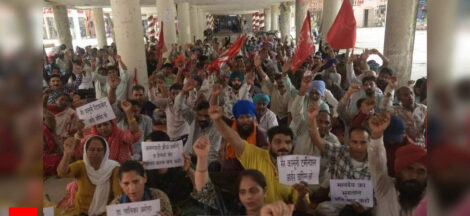Some twenty years back a division bench of Patna High Court had bemoaned the absence of work culture in Bihar. The officials who have the authority to enforce the work ethics are reluctant to improve the governance and ensure that the subordinates perform. Division bench of Justice V N Sinha and Justice Prabhat Kumar Jha had directed the government to furnish a list of the officials who held the posts of chief secretary, principal secretary (health) and director-in-chief (health services) since 2002. It had also sought the information why its order to provide 500 beds at the mental asylum at Koelwar in Arrah was not complied with.
An aggrieved Division bench had observed “This shows there is no work culture in the government. Once the commitment was made by the then chief secretary but he could not fulfil it during his tenure, it was the responsibility of the officers succeeding him to fulfil the promise”. Judges anger and their rebuke nevertheless failed to move the thick-skinned bureaucracy. What was most disgraceful was senior bureaucrats of health department approaching the bench for reducing the target to 250 beds from 500 beds.
Annoyed with bureaucratic trickery judges finally decided to seek an undertaking that they would at least provide 250 beds in the asylum by October 10, 2014, which is observed every year as the World Mental Day.. This manifests boorish audacity and lack of concern of the state administration towards the people. The officials instead of furnishing any undertaking requested the court to reduce it to 150 as the government needed more time to build infrastructure.
Strange was the argument. The bureaucrats can bring moon for their political masters within no time, but they were helpless in carrying out the order of the High Court but tragically were trying to hide behind the façade of the inability of the government in the case of providing beds. This one small incident is sufficient to illustrate why Bihar is languishing and corruption rules the roost. With a subservient and corrupt bureaucracy, it would be naïve to construe that state administration will be responsible to the people and act in a fair manner.
In 2009 while on tour to Siwan in North Bihar, this correspondent happened to meet a young upper caste entrepreneur. He had started his furniture making business only a couple of years back. He was too happy with the governance of Nitish Kumar. He said “we are feeling relieved. Now we have a government which means business and is committed to carry out all round development. People have rightly named him Nitish Kumar as Sushasan Babu. The roads which had earlier earned the nickname of “Garbhpa” (miscarriage) roads have now acquired a new shape. Travelling time has been substantially reduced”.
He was however noncommittal in replying whether it would survive for some time. When asked is it like a white chalk dot on a big blackboard, he quipped “we will have to wait”. While Lalu Yadav as chief minister did not spend the government fund for development and most of it was returned to Centre, Nitish used the funds. A new class of contractors from upper as well OBC sprang. Most of these lacked technical expertise and knowhow but they undertook projects which included bridges, flyovers and roads.
Incidentally three bridges collapsed in the first week of July in the Saran district. Out of the three bridges in Saran, two on the Gandak River, barely a kilometre apart, collapsed within two hours. A senior engineer of PWD confided that the technocrats prepared an inflated project as the contractor has to reach the money to every person who matters; right from minister to lower division clerk, even peons. The contractor in pure terms is left with 40 per cent of the real fund to do the job. This includes his own profit. In fact not more than 20 per cent of the fund is spent on the project. They minimize the cost and material consumption. If not checked by higher authorities, they will not do any work accurately. In most of the cases they use sand more than cement as stipulated. Their main objective has been to earn.
The main reasons for bridges, irrigation structures collapsing or showing signs of distress are flawed designs, poor tendering system, allotting contracts to the favoured persons those who are close to politicians, and absolute shortage of skilled engineers. These contractors primarily depend on the masons for completing the projects. The technical authorities seldom visit the project sites. The contractors usually send the money bill and the officials clear them sitting in their offices.
Proper execution of project is the responsibility of the engineers and officials. They are supposed to carry out regular monitoring. But seldom they undertake this task. Nitish Kumar or his ministers are reluctant to take action against these intractable officials. There is a very interesting but bizarre aspect of the entire operation. It is usually presumed that Nitish has a strong support base in the extremely backward castes. Undoubtedly he enjoys their support, but he is primarily dependent on Kurmis and Koiris, the agricultural castes. Nitish himself is from Kurmi.
It is interesting to watch that most of the technical staff the engineers are from Koiri and Kurmi castes. They had graduated from the private engineering colleges in Karnataka and Maharashtra. The contractors are from upper castes, but again a sizeable number of them are from Kori and Kurmi communities. A sort of engineer-contractor nexus has developed.
Never in the past such a large number of bridges had collapsed in the state as has happened during last 17 days. Notable incidents include the June 2020 bridge collapse incidents in Bhagalpur and Sattarghat, the latter just 29 days after inauguration. The officials often cite “God’s hand” behind the collapse and site desilting of the rivers or some intangible reason. About 14 months ago, parts of under-construction Sultanganhj Aguwani bridge collapsed in the Bhagalpur district due to loose cable. The same four-lane bridge caved in again in June this year.
In July 2020, just after 29 days of inauguration, the Sattarghat bridge over the Gandak river in Gopalganj district collapsed due to heavy rain and strong currents. On November 18, 2022, an under-construction road bridge in Nalanda district collapsed claiming one life. Yet another under-construction bridge in Purnia collapsed four hours after concretisation on May 16, 2024. The locals accused the contractor and the engineers of using low-quality material. Two bridges collapsed back to back in Kisanganj between June 27 and June 30.
Another bridge was damaged on the Maria river in Kisanganj. This bridge was built in 2011.On June 23, an under-construction bridge collapsed in East Champaran. Three bridges collapsed Siwan district on July 3. Another under-construction bridge on river Bakra in Arari collapsed on June 18. Out of the 13 bridges three were old and the rest were under-construction. Obviously, it unravels the quality and nature of the work and the manpower used.
Collapse of the old bridges, one even hundred-year-old, underlines that the officials are not all concerned of repair and maintenance of these bridges. Nitish government has taken action by suspending 15 engineers holding them responsible for the collapse of the bridges. But this is simply an eye wash. The Bihar government officials are not worried of suspensions. The government has no answer to the peoples’ query why they are not outright sacked.
Collapse of under-construction bridges raises serious concerns about the quality of construction practices, oversight and lack of accountability within the state’s infrastructure projects. The situation has attained such an alarming proportion that even BJP leader Dr. Nikhil Anand was forced to say; “I am afraid of crossing through any flyover or bridge in Bihar. Surprised that in last 10 days half a dozen bridges have collapsed. A serious probe & auditing is needed. The responsibility be fixed on the construction company, blacklist them. The engineers must be booked”.
Poor quality of repair and maintenance has been primarily responsible for collapse of Cyclopean Wall a heritage site in Rajgir. Two sections of the wall, including a 20-foot long and 12-foot wide portion, crumbled near Banganga last Friday following heavy rain, raising a question mark on the upkeep of the 2,600-year-old structure that was being considered for inclusion in UNESCO’s World Heritage List. Instead of confessing their failure, the ASI officials put the blame on rain: “The Cyclopean Wall has subsided at two places. There has been incessant rain in the area. People living in the villages there also pointed to a lightning strike in the vicinity”.
The 45km wall with height varying from 3ft to 15ft and width between 12ft and 14ft in the midst of hills encircles Rajgir, the capital of the ancient Magadh Empire. It was repaired in 1944 under the supervision of the then ASI director-general, Mortimer Wheeler. The Wall is similar to the “Frontiers of the Roman Empire” or the “Roman Limes”, which was built in the 2nd century AD and ran across present-day Germany, the UK and Northern Ireland.
It is strange that how could Nitish who has been showing his extreme concern for Nalanda University, bother to ignore this wall. In fact the people assert that the condition of wall has been deteriorating for many years. It has been broken and vandalised in several places. Though it is in home district of chief minister Nitish Kumar and he frequently visits Nalanda, he never took the pain to see the wall.
Like the health department officials wailing that the department was facing the crunch of resources, the ASI officials blame shortage of resource. A senior official said; “There are several issues pertaining to the conservation of the Rajgir Cyclopean Wall. We are facing a resource and manpower crunch. It maintains the easily visible portions of the wall but neglects the sections that are located out of sight or in forested areas. Bushes and trees have grown at several places on the massive wall, weakening its structure”. It appears the government officials have a xerox copy of the readymade replies for concealing their failures. (IPA Service)



